
Key Resource: Climate Change and Adaptation
This chapter focuses on the effects of climate change on rail infrastructure along the existing Northeast Corridor (NEC) and proposed Tier 1 Draft Environmental Impact Statement (Draft EIS) Action Alternatives.
This assessment identifies areas of the existing and proposed rail infrastructure that may be vulnerable to the effects of climate change, including sea level rise and storm surge, increased storm frequency and severity, and more-frequent and severe extreme heat and cold events. Climate change effects on rail infrastructure can result in delays and closure of rail services and assets. An important consideration for the Federal Railroad Administration (FRA) is to understand areas that are vulnerable to the effects of climate change and to minimize those effects through future planning, design, and potential adaptation features of those assets.
This chapter also considers the analysis of greenhouse gases (GHG) presented in Chapter 7.13, Air Quality. GHG emissions are a key contributor to the changing global climate and influence the frequency and intensity of storms, rising sea levels, heat waves, and cold snaps.
Each state within the Study Area has legislative or policy actions that support consideration of climate change adaptation in their policies, programs, and investment decisions. The FRA reviewed the U.S. Department of Transportation's (U.S. DOT) 2014 Climate Adaptation Plan and climate change-related policies and initiatives that have been published by various government agencies in Washington, D.C., and the eight states along the NEC. From these sources, the FRA identified the following common themes:
The FRA developed a climate change analytical approach for this Tier 1 Draft EIS to be consistent with these themes. In particular, this analysis seeks to identify where infrastructure may be most vulnerable; to provide information to support identifying a Preferred Alternative that can improve resiliency and provide redundancy; and to coordinate with relevant planning agencies, infrastructure owners, and operators in incorporating previous studies and planning efforts.
The U.S. Environmental Protection Agency describes climate change as any significant change in the measures of climate lasting for an extended period, which includes major changes in temperature, precipitation, or wind patterns (among other effects) that occur over several decades or longer.1 This analysis includes consideration of the following climate impact categories:
The FRA developed an effects-assessment methodology for the climate change assessment. The methodology provides a detailed definition of climate change, data sources, an explanation on how the FRA defined and established the Affected Environment, and how it evaluated and reported the effects of climate change.
The FRA assessed current climate conditions and the following two future climate scenarios:
The FRA used this multi-scenario approach to analyze different levels of climate change-related effects that encompass the range of projections and forecast timeframes used by researchers and regulatory agencies in the Northeast.
The FRA used each of these climate scenarios to examine how climate change would affect the existing NEC over time; the climate change effects on the existing NEC serve as a baseline against which the FRA can compare the effects of climate change on the Action Alternatives. The FRA applied the near- and long-term scenarios to each Action Alternative to understand how proposed improvements associated with each Action Alternative affects the resiliency of the NEC passenger rail system to sea level rise flooding, coastal storm flooding and riverine flooding, and extreme heat events. Extreme cold events are less well documented; therefore, a qualitative analysis of the effects of extreme cold events is presented. Table 7.15-1 summarizes key factors associated with the climate change and adaptation methodology. (Appendix E, Section E.15 provides more detailed information.)
| Climate Change Effects | Affected Environment | Type of Assessment | Outcome |
|---|---|---|---|
| Sea level rise flooding | 2,000 feet, centered on the Representative Route | Quantitative: Acres | Identification of counties and Alternatives at highest risk of inundation |
| Coastal storm surge flooding | 2,000 feet centered on the Representative Route | Quantitative: Acres | Identification of counties and Alternatives at highest risk of inundation |
| Riverine flooding | 2,000 feet centered on the Representative Route | Quantitative: Percentage increase in flood hazard zone | Percentage increase in flood hazard zones within each state and identification of counties and Alternatives at highest risk of inundation |
| Extreme heat events | Study Area | Quantitative: Change in the annual number of days over 80°F, 95°F and 110°F. (number of days) |
Qualitative discussion of potential effects of an increase in extreme heat on rail infrastructure |
| Extreme cold events | Study Area | Qualitative | Qualitative discussion of potential effects of extreme cold days on rail infrastructure |
Source: NEC FUTURE Climate Change Affects Assessment Methodology, Appendix E, E.15, 2014.
Data and analysis presented for the Affected Environment provide some understanding of the extent of flooding; however, to better understand the effects of inundation risks associated with climate change on the existing and proposed rail infrastructure, it is important to focus on the narrower Representative Route. This analysis presents a series of graphs that show the percentage of the total acreage for the Affected Environment and Representative Route at risk from noted flooding hazards. This "cumulative" approach allows the analysis to show the total acreage at risk from an end-to-end perspective. To establish a point of reference, or baseline, analysis of the existing NEC is included. All of the Action Alternatives incorporate improvements to the existing NEC. However, to better understand the inundation risks associated with new infrastructure, or off-corridor segments, associated with the Action Alternatives, these off-corridor segments have been extracted to help show how the inundation risks of these segments compared to those on the existing NEC. Both analyses are presented-one showing each climate change effects on each alternative end-to-end, inclusive of the existing NEC, as well as a focused analysis comparing the risks associated with the existing NEC separate from the proposed off-corridor segments associated with each Action Alternative. In this way, the climate change analysis informs the evaluation of the alternatives, by examining not only the resiliency and vulnerability of the improvements associated with each Action Alternative, but also the effectiveness of the redundant capacity each Action Alternative proposes.
The assessment of climate change effects aims to identify which of the Action Alternatives are at greatest risk from climate change-related effects, based on the use of existing and readily available data and information that are consistent across the Study Area. This assessment estimated the change in flood hazard areas but did not undertake flood modeling to develop new inundation maps for future climate scenarios for all counties within the Study Area.
When reviewing the findings of this assessment, the FRA applied the following limitations:
Refer to Appendix E, Section E.15, for further discussion regarding the limitations of the climate change analysis.
Increases in GHG emissions contribute to changes in the global climate and weather events, which can lead to flooding, storm surges, and extreme heat and cold. As the climate continues to change, more-intense and more-frequent storms, rising sea levels, heat waves, and cold snaps3 will worsen existing weather-related rail problems and create new hazards for rail asset owners and operators. Inundation from flooding presents significant risks to rail assets by restricting access, undermining foundations, damaging assets, and increasing maintenance and repair requirements. Inundation may be permanent as a result of sea level rise or temporary due to storm surge or riverine flooding. Extreme heat events increase the risk of track buckling and potential electrical failures from sagging catenary wires and overheating power supplies. Extreme cold temperatures also affect tracks, increasing the likelihood of track separations. Snow and ice may also affect equipment, access, and operations. This analysis shows that some of the rail assets associated with the existing NEC and those affiliated with the Action Alternatives are in areas currently vulnerable to climate change effects, and that the risks increase over the mid-century and end-of-century.
While the focus of this assessment is on flooding and temperature-related impacts, climate change will worsen other natural hazards (e.g., increasing incidences of high wind events and acidification of ocean water). Table 7.15-2 summarizes the likely impacts of these natural hazards to rail assets relevant to the NEC. The following Environmental Consequences may result from the identified impacts to rail assets:
Damage to rail assets and disruption to services will also result in financial and social consequences due to the need to repair or replace assets, service delays to passengers, and potential safety risks, such as risks associated with a derailment and mobilization of contaminants.
The following are key findings of this analysis:
Table 7.15-2 : Flooding and Extreme Temperature-Related Impacts to Rail Assets and Operations
GHG emissions are a key contributor to the changing global climate. Continued increases in global GHG emissions are projected to lead to more significant changes in extreme weather events and their associated risks to rail assets and operations. The analysis presented in Chapter 7.13, Air Quality, and Chapter 5, Transportation Effects, indicates that under all Action Alternatives, there would be a net total decrease in GHG emissions in the year 2040 due to predicted shifts in mode choice as a result of implementing any of the Action Alternatives and predicted changes in greater renewable energy usage.
As such, implementation of any of the Action Alternatives would likely be a lesser contributor to GHG emissions affecting climate change, when compared to the No Action Alternative.
The analysis presented in this section shows that portions of the existing NEC and the Representative Routes of all Action Alternatives have some risk of inundation under current climate conditions. The extent of that risk increases under both the mid-century and end-of-century scenarios. The following subsections discuss the current, mid-century, and end-of-century inundation risks (sea level rise and coastal storm surge) for the existing NEC and all Action Alternatives. While the FRA assessed the mid-century and end-of-century riverine flood risk for the Affected Environment, because of limitations in readily available information, the FRA applied only the current climate conditions to the analysis of the Representative Route for riverine flooding (see Section 7.15.1.3).
Much of the existing NEC is along the eastern shoreline of the United States and either crosses or is adjacent to numerous streams, rivers, wetlands, and floodplains, rendering it susceptible to inundation from various sources (see Chapter 7.5, Hydrologic/Water Resources). Under current climate conditions, of the total area within the Affected Environment, 3 percent is at risk for flooding associated with sea level rise; 10 percent is at risk for flooding associated with storm surge flooding; and 19 percent is at risk for flooding associated with riverine flooding. Under the mid-century and end-of-century scenarios, these inundation risks associated from the same sources increase. Under the end-of-century scenario, risks associated with sea level rise increase to nearly 10 percent; increase to almost 20 percent with storm surge flooding; and increase to over 30 percent with riverine flooding.
For each flooding hazard, Connecticut (Fairfield, New Haven, Middlesex, and New London Counties) contains the highest percentages of lands within the Affected Environment susceptible to each flooding hazard.
When focusing on the land encompassed by the right-of-way of the existing NEC-and not the broader Affected Environment-the percentage of land area within that right-of-way at risk is 1 percent (sea level rise), 8 percent (storm surge flooding), and 13 percent (riverine flooding). Under the end-of-century scenario, those flooding risks for the route of the existing NEC increase to approximately 6 percent (sea level rise) and 20 percent (storm surge flooding) (the assessment of riverine flooding risk was conducted only for the current climate conditions).
Figure 7.15-1 shows the risk profiles of each flooding hazard for each state and county for the Affected Environment for the current climate conditions as well as the mid-century and end-of-century scenarios. Figure 7.15-2 shows the same for the route of the existing NEC.
The No Action Alternative includes improvements that primarily exist along the existing NEC. As such, the analysis presented for the existing NEC provides a good proxy for identifying inundation risks associated with the No Action Alternative. As the climate changes, the risks associated with flooding are likely to increase, hastening the degradation of assets along the existing NEC. Without investment to provide more resilient infrastructure repair and maintenance costs, disruptions to services are projected to increase under the No Action Alternative as a result of the effects of climate change.
Similar to the existing NEC and No Action Alternative, all Action Alternatives would be at risk from all flooding hazards under current climate conditions. Figure 7.15-3 through Figure 7.15-5 compare the cumulative percentage of the total acreage in the Affected Environment at risk for each flood hazard for all Action Alternatives. While the total percentage of Affected Environment at risk from flooding varies depending on the flood hazard, the existing NEC has the highest percentage of acreage in the Affected Environment at risk for all flooding hazards. Alternative 1 has the next highest percentage of total acreage at risk from flooding hazards, followed by Alternative 2, and lastly all Alternative 3 route options. There is some variation within the Alternative 3 route options as to which has the lowest percentage of the Affected Environment at risk for each hazard. For example, Alternative 3 via Long Island/Worcester (Alternative 3.3) has the lowest percentage of the Affected Environment at risk from sea level rise and storm surge flooding, while Alterative 3 via Long Island/Providence (Alternative 3.2) has the lowest percentage of the Affected Environment at risk from riverine flooding. While the existing NEC is included in the analysis of each Action Alternative, the percentage of acres at risk in the Action Alternatives is lower because the total number of acres at risk does not increase proportionally with the increase in size of the Affected Environment associated with each Action Alternative, thus making the percentage lower.
The percentage of the total acreage in the Affected Environment at risk is projected to increase for all flood hazards and Action Alternatives under the mid-century and end-of-century climate scenarios (refer to the inserts in Figure 7.15-3 through Figure 7.15-5). For sea level rise flooding, the greatest increase in the number of acres at risk is likely to occur between mid-century and end-of-century climate conditions. For storm surge flooding, the greatest increase is likely to occur between current climate conditions and mid-century. For riverine flooding, the increase in number of acres at risk is likely to be relatively consistent between each time period. Each flooding hazard is discussed in more detail below. Discussion of the existing NEC is included to show relative changes in flooding hazards.
Figure 7.15-1 : Current Climate Conditions (All Flooding Hazards): Cumulative Percentage of the Total Acreage in the Affected Environment along the Existing NEC at Risk
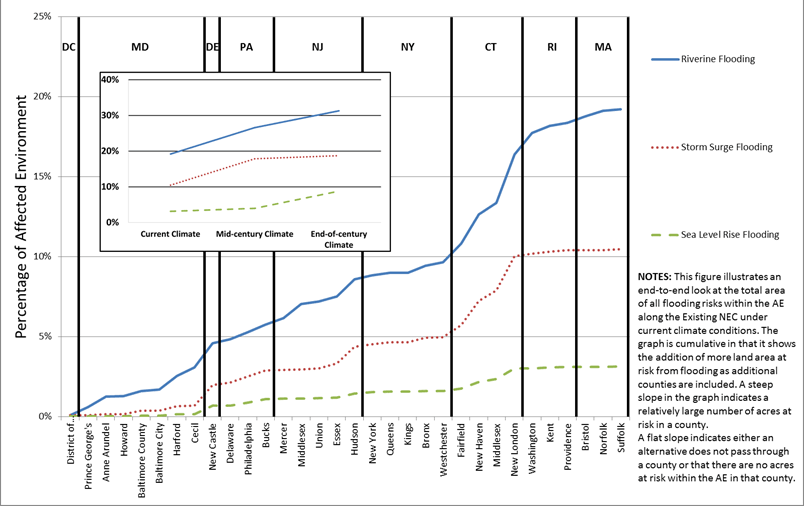
Source: NEC FUTURE team, 2015
Figure 7.15-2 : Current Climate Conditions (All Flooding Hazards): Cumulative Percentage of the Total Acreage in the Representative Route along the Existing NEC at Risk
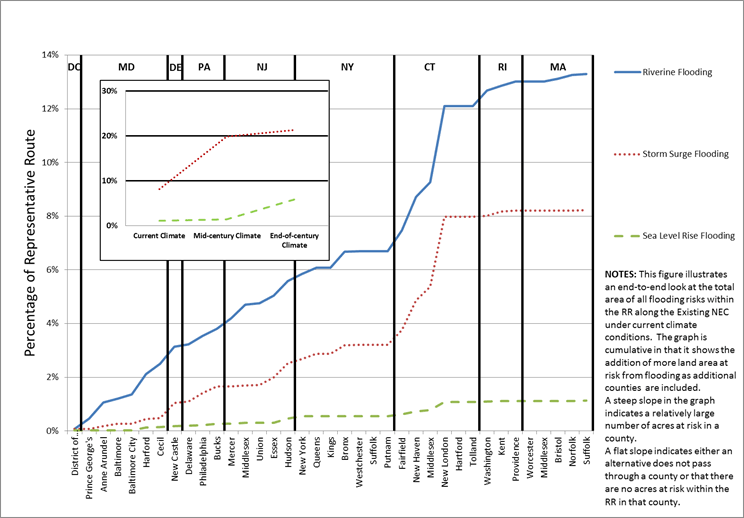
Source: NEC FUTURE team, 2015
Note: There is no insert for the change in riverine flood risk over time because the assessment of riverine flooding risk in the Representative Route was only conducted for the current climate conditions.
Figure 7.15-3 : Current Climate Conditions (Sea Level Rise Flooding): Cumulative Percentage of the Total Acreage in the Affected Environment of the Action Alternatives at Risk
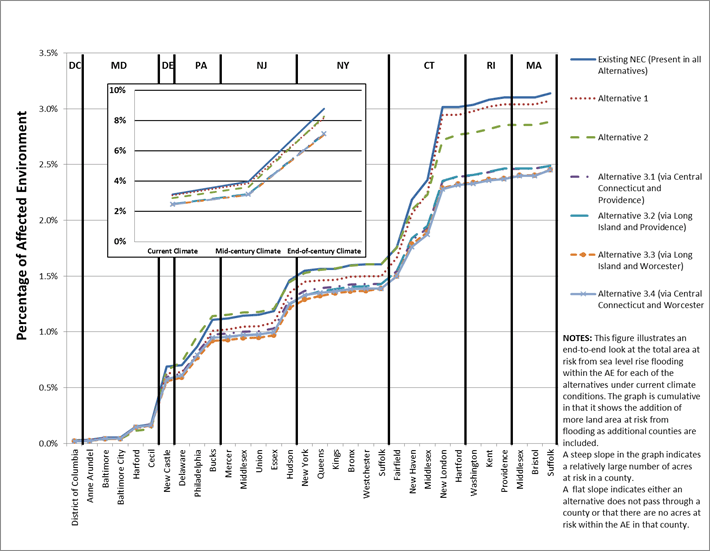
Source: NEC FUTURE team, 2015
Figure 7.15-4 : Current Climate Conditions (Storm Surge Flooding): Cumulative Percentage of the Total Acreage in the Affected Environment of the Action Alternatives at Risk
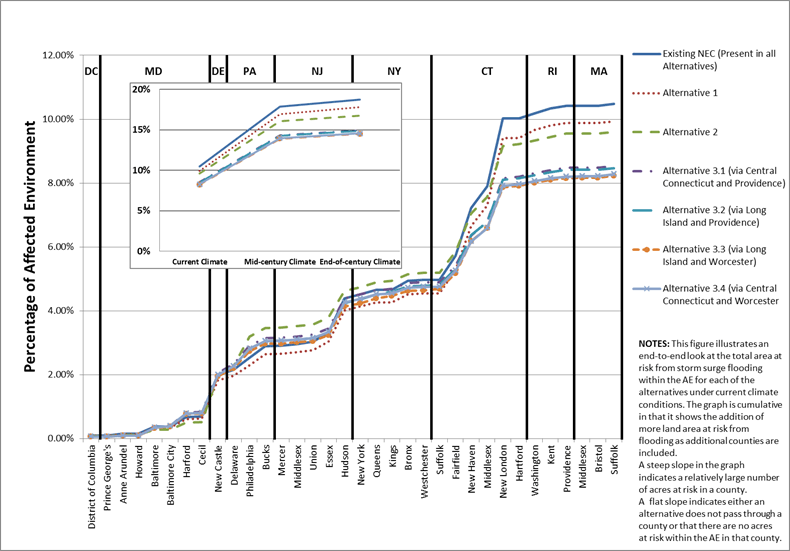
Source: NEC FUTURE team, 2015
Figure 7.15-5 : Current Climate Conditions (Riverine Flooding): Cumulative Percentage of the Total Acreage in the Affected Environment of the Action Alternatives at Risk
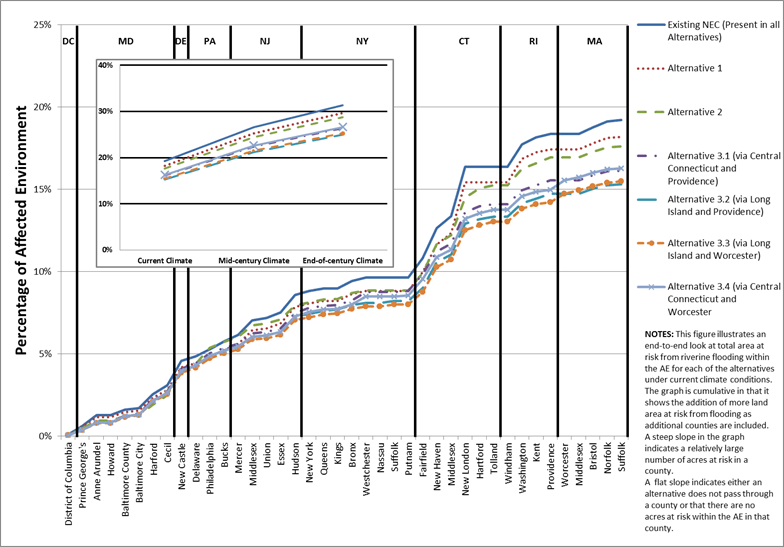
Source: NEC FUTURE team, 2015
The percentage of the Representative Route at risk from sea level rise flooding for the existing NEC and all Action Alternatives ranges 1-1.5 percent of the total acreage (Figure 7.15-6) within the Representative Route. The existing NEC has the lowest percentage of the Representative Route at risk from storm surge flooding under the current and mid-century climate conditions with Alternative 3 via Long Island/Providence (Alternative 3.2) and Alternative 3 via Long Island/Worcester (Alternative 3.3) being the next lowest.
Under end-of-century climate conditions, the percentage of the Representative Route at risk from sea level rise flooding for all Action Alternatives is likely to increase 5-6 percent. Between the mid-century and end-of-century, the ranking of which Action Alternative has the lowest percentage of the Representative Route at risk from sea level rise changes, with Alternative 3 via Long Island/Providence (Alternative 3.2) and Alternative 3 via Long Island/Worcester (Alternative 3.3) having the lowest percentage of the Representative Route at risk from sea level rise flooding. Alternative 2 has the highest percentage of the Representative Route at risk for sea level rise flooding and the existing NEC has the second highest percentage of the Representative Route at risk (Figure 7.15-6 insert), although the differences are relatively minor.
Under current climate conditions, the percentage of the Representative Route at risk from coastal storm surge flooding for all Action Alternatives range 7-8 percent of the total acreage (Figure 7.15-7) within the Representative Route. The Alternative 3 route options have the lowest total percentage of acreage at risk from coastal storm surge flooding. The existing NEC, Alternative 1, and Alternative 2 have the highest percentages of the Representative Route at risk (Figure 7.15-7 insert).
The total percentage of the Representative Route at risk of coastal storm surge flooding is likely to increase to 15-20 percent under mid-century climate conditions and 16-21 percent under end-of-century climate conditions. For each timeframe, the Actions Alternatives maintain the same comparative ranking at risk from coastal storm surge as stated for the current climate conditions. Alternative 3 via Long Island/Providence (Alternative 3.2), followed by Alternative 3 via Long Island/Worcester (Alternative 3.3), have the lowest percentage of the Representative Route at risk for all timeframes; indeed all Alternative 3 route options notably reduce the percentage of acres within the Representative Route at risk of coastal storm surge flooding. The existing NEC has the highest percentage of the Representative Route at risk for all timeframes (refer to the insert in Figure 7.15-7).
Under current climate conditions the percentage of the Representative Route at risk of riverine flooding for the existing NEC and all Action Alternatives range 12-14 percent of the total acreage. Alternative 3 via Long Island/Providence (Alternative 3.2) has the lowest total percentage of acreage at risk of riverine flooding (Figure 7.15-8). Alternatives 2 and Alternative 3 via Central Connecticut/Worcester (Alternative 3.4) have the highest percentage of the Representative Route at risk.
Figure 7.15-6 : Current Climate Conditions (Sea Level Rise Flooding): Cumulative Percentage of the Total Acreage in the Representative Route of the Action Alternatives at Risk
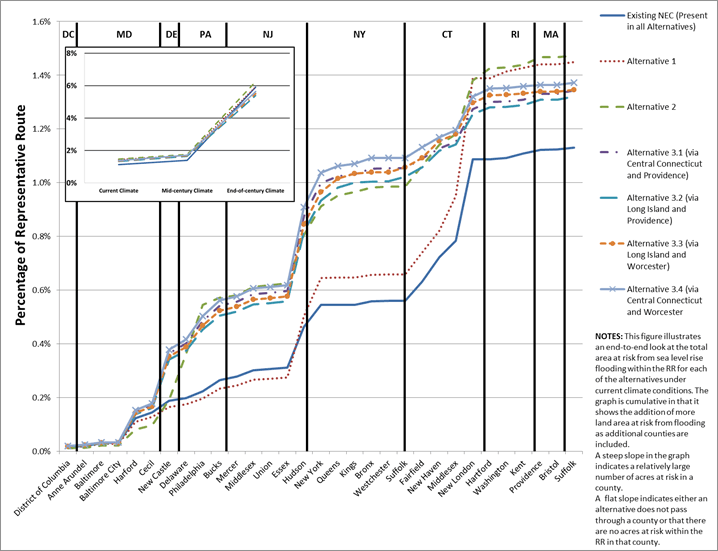
Source: NEC FUTURE team, 2015
Figure 7.15-7 : Current Climate Conditions (Storm Surge Flooding): Cumulative Percentage of the Total Acreage in the Representative Route of the Action Alternatives at Risk
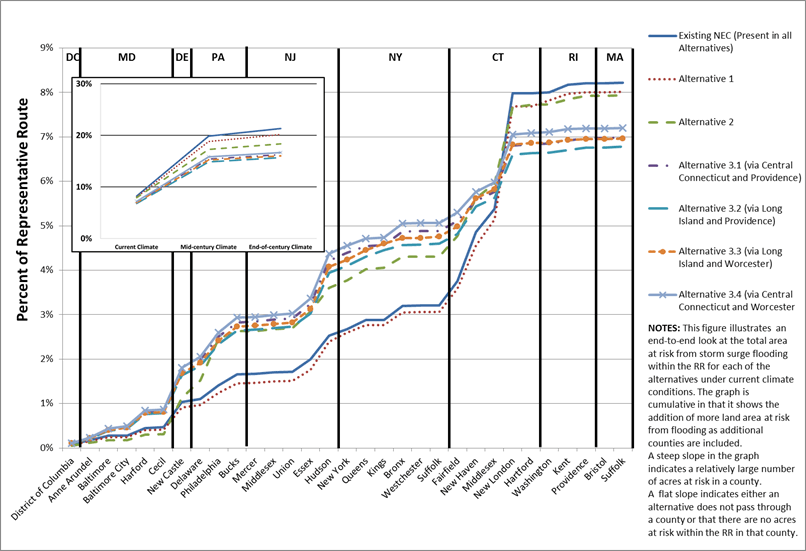
Source: NEC FUTURE team, 2015
Figure 7.15-8 : Current Climate Conditions (Riverine Flooding): Cumulative Percentage of the Total Acreage in the Representative Route of the Action Alternatives at Risk
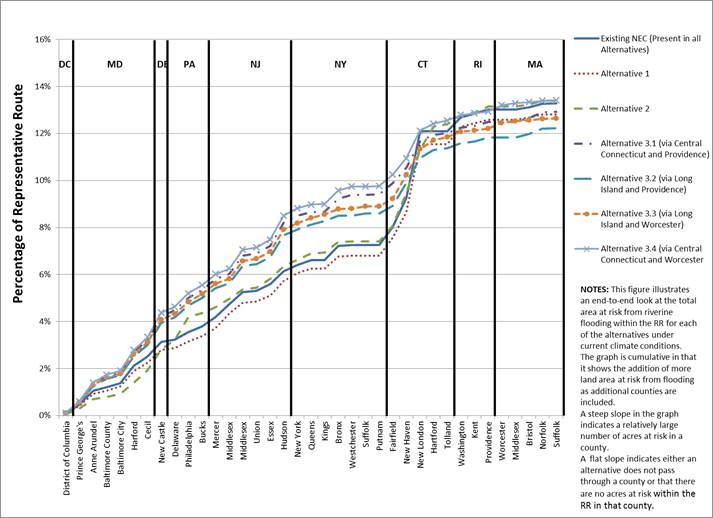
Source: NEC FUTURE team, 2015
Note: There is no insert for the change in riverine flood risk over time because the assessment of riverine flooding risk in the Representative Route was only conducted for the current climate conditions.
As noted in Section 7.15.4, the FRA conducted an assessment of riverine flooding risk on the Representative Route only for the current climate conditions; however, it is likely that the total percentage of the Representative Route at risk of riverine flooding will also increase under mid-century and end-of-century climate conditions.
Table 7.15-3 summarizes the three counties located along the Representative Routes of the Action Alternatives that have, or are proposed to have, rail assets located where the highest total acreage at risk from each flood hazard occur under current climate conditions. Also included in the table is the percentage of the total acreage within the Representative Routes at risk of flooding accounted for by these three counties. It is notable that New London, CT, consistently represents one of the counties at highest risk of all types of flooding under all Action Alternatives (with the exception of sea level rise flooding under Alternative 3).
| Flooding Hazard | Existing NEC | Alt. 1 | Alt. 2 | Alt. 3 |
|---|---|---|---|---|
| Sea level rise flooding |
|
|
|
|
| Storm surge flooding |
|
|
|
|
| Riverine flooding |
|
|
|
|
Source: NEC FUTURE team, 2015
In Section 7.15.4.3, the analysis included the existing NEC in all Action Alternatives for the purposes of calculating the percentage of the Representative Route at risk from each flooding hazard. As a result, it was not obvious how the off-corridor segments of each Action Alternative would provide resilience benefits by providing an alternate route that could assist in maintaining services if coastal or riverine inundation issues (or other hazards) affect assets along the coast of Connecticut and Rhode Island. The analysis presented in this section concentrates on the areas where off-corridor routing is proposed, because all Action Alternatives generally follow the existing NEC between Washington, D.C., and New York City. This analysis focuses on Connecticut and Rhode Island as areas where off-corridor routing is proposed as part of all Action Alternatives.
To identify the comparative level of risk between the existing NEC and select off-corridor segments of the Action Alternatives, this section focuses on the percentage of the acreage in the Representative Route at risk from all flooding hazards under current climate conditions. The focus is on current climate conditions since it simplifies the analysis while still determining the comparative level of risk between the existing NEC and the Action Alternatives. The analysis provides a look at a comparative segment of the existing NEC to the proposed off-corridor route. As indicated in Figure 7.15-6 to Figure 7.15-8, the risks from each flooding hazard identified in this section are likely to increase under mid-century and end-of-century climate conditions.
Within the Representative Route, additional analysis focuses on at-grade and trench construction types, as they are more sensitive to flood risk than other construction types (e.g., tunnel, aerial, embankment, and major bridge). While at-grade and trench construction types are the focus of the assessment, flooding impacts may still affect tunnels, embankments and bridge construction types (for example via scour or erosion).
The analysis in this section indicates that the off-corridor segments of the Action Alternatives all have a lower percentage of the Representative Route at risk from each flooding hazard than the comparative segments of the existing NEC. While the total number of acres at risk of inundation within each Action Alternative (and the existing NEC) is likely to increase under mid-century and end-of-century climate conditions, the Action Alternatives are likely to continue to have a lower risk profile than the existing NEC.
An off-corridor segment of Alternative 1 includes the Old Saybrook-Kenyon new segment between Middlesex County, CT, and Washington County, RI, which is off the existing NEC. Figure 7.15-9 compares the percentage of the total acreage in the Representative Route at risk from all flooding hazards under current climate conditions for this new segment. There is minimal difference in the risk from sea level rise flooding between the existing NEC and the Old Saybrook-Kenyon new segment proposed under Alternative 1, with both routes having approximately 3 percent of the total acreage in this segment at risk. However, this new segment has significantly less acreage at risk from both coastal storm surge flooding (6 percent) and riverine flooding (9 percent) when compared to the existing NEC (25 percent and 29 percent, respectively). For all flooding hazards, New London County, CT, accounts for the greatest number of acres at risk (as evidenced by the steep increase in the lines on Figure 7.15-9).
Considering the constructions types that are most vulnerable to inundation from flooding, Figure 7.15-10 further emphasizes the resilience benefits of Alternative 1 in this area. Less than 0.5 percent of the acreage at risk in the Representative Route relate to at-grade or trench construction type, compared to approximately 14 percent of the existing NEC.
Figure 7.15-9 : Current Climate Conditions (All Flooding Hazards): Old Saybrook-Kenyon New Segment - Cumulative Percentage of the Total Acreage in the Representative Route of the Existing NEC and Alternative 1 at Risk
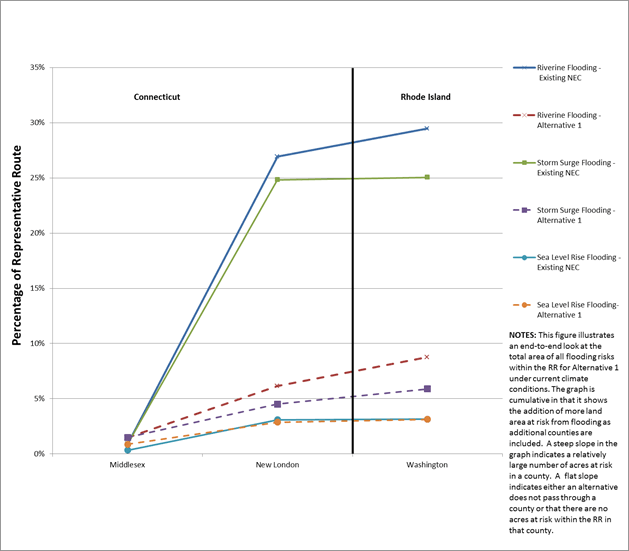
Source: NEC FUTURE team, 2015
Figure 7.15-10 : Current Climate Conditions (Storm Surge and Riverine Flooding): Construction Type - Total Percentage of Representative Route of Alternative 1 and the Existing NEC at Risk (Old Saybrook-Kenyon New Segment)
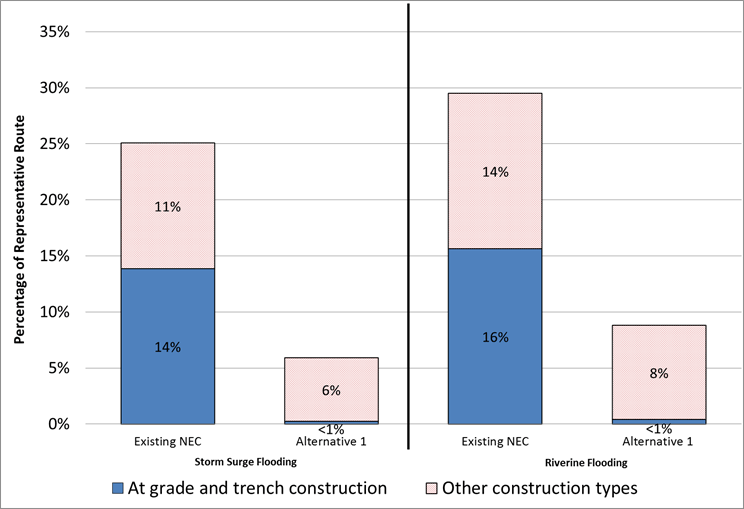
Source: NEC FUTURE team, 2015.
Alternative 2 includes a segment between New Haven County, CT, and Providence County, RI, that is off the existing NEC corridor. Figure 7.15-11 compares the percentage of the total acreage in the Representative Route at risk from all flooding hazards under current climate conditions. There is minimal difference in the risk from sea level rise flooding between the existing NEC and Alternative 2 in this area, with both routes having less than 1 percent of the total acreage in this segment at risk. This new segment of Alternative 2 has considerably less acreage at risk from both coastal storm surge flooding (1 percent) and riverine flooding (9 percent) when compared to the existing NEC (8 percent and 20 percent, respectively) in this same area. For all flooding hazards, for the existing NEC, New London County, CT, accounts for the greatest number of acres at risk (as evidenced by the steep increase in the lines on Figure 7.15-11). For Alternative 2, New Haven County, CT, has the highest number of acres at risk from storm surge flooding, and Hartford County, CT has the highest number of acres at risk from sea level rise flooding and riverine flooding.
Considering the constructions types that are most vulnerable to inundation from flooding, Figure 7.15-12 further emphasizes the resilience benefits of Alternative 2 in this area. For both storm surge flooding and riverine flooding, this new segment of Alternative 2 has a lower number of acres of at-grade or trench construction type at risk.
Alternative 3 includes two route options between New York County, New York, and Hartford, CT, and two options between Hartford, CT, and Suffolk County, MA, that are off the existing NEC. Figure 7.15-13 and Figure 7.15-15 compare the percentage of the total acreage in the Representative Route at risk from storm surge flooding and riverine flooding, respectively. Sea level rise flooding has not been included because design and emergency management planning decisions typically focus on the 100-year storm events that are represented by coastal storm surge flooding and riverine flooding analysis.
All Alternative 3 route options have a lower percentage of the Representative Route at risk from storm surge flooding compared to the existing NEC (approximately 4-5 percent compared to 26 percent for the existing NEC). Of the Alternative 3 route options, Alternative 3 via Central Connecticut/Providence (Alternative 3.1) has the lowest percentage of the Representative Route at risk of storm surge flooding, and Alternative 3 via Central Connecticut/Worcester (Alternative 3.4) has the highest, though there is no significant difference among the Alternative 3 route options.
All Alternative 3 route options have a lower percentage of the Representative Route at risk from riverine flooding compared to the existing NEC (between approximately 6 percent and 10 percent compared to 15 percent for the existing NEC). Of the Alternative 3 route options, Alternative 3 via Long Island/Providence (Alternative 3.2) has the lowest percentage of the Representative Route at risk of riverine flooding, and Alternative 3 via Central Connecticut/Worcester (Alternative 3.4) has the highest.
Figure 7.15-11 : Current Climate Conditions (All Flooding Hazards): New Haven-Hartford-Providence - Cumulative Percentage of the Total Acreage in the Representative Route of Action Alternative 2 and the Existing NEC at Risk
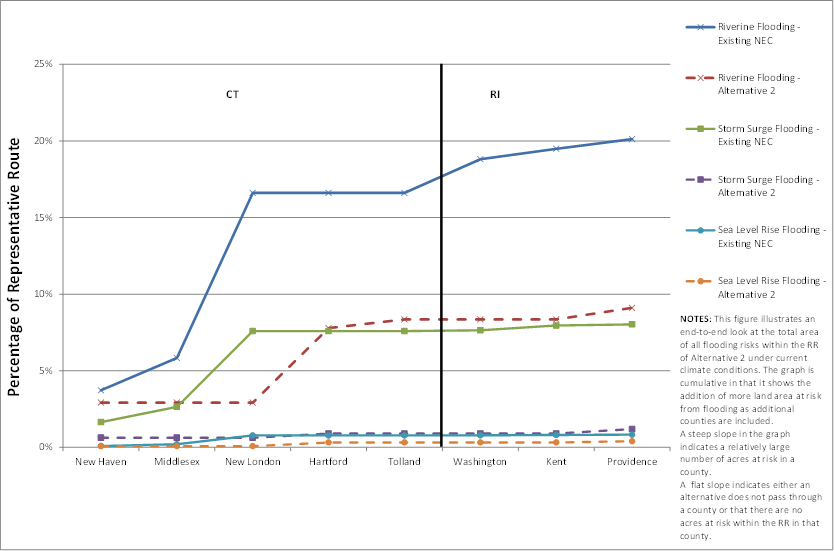
Source: NEC FUTURE team, 2015
Figure 7.15-12 : Current Climate Conditions (Storm Surge and Riverine Flooding): New Haven-Hartford-Providence - Construction Type - Total Percentage of Representative Route of Alternative 2 and the Existing NEC at Risk
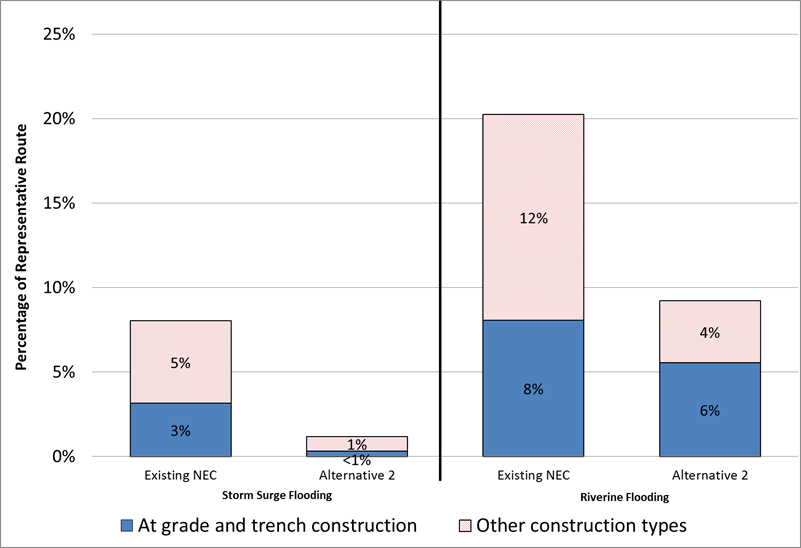
Source: NEC FUTURE team, 2015.
Figure 7.15-13 : Current Climate Conditions (Storm Surge Flooding) Cumulative Percentage of the Total Acreage in the Representative Route of Action Alternative 3 (New York County, NY and Suffolk County, MA Route Option)
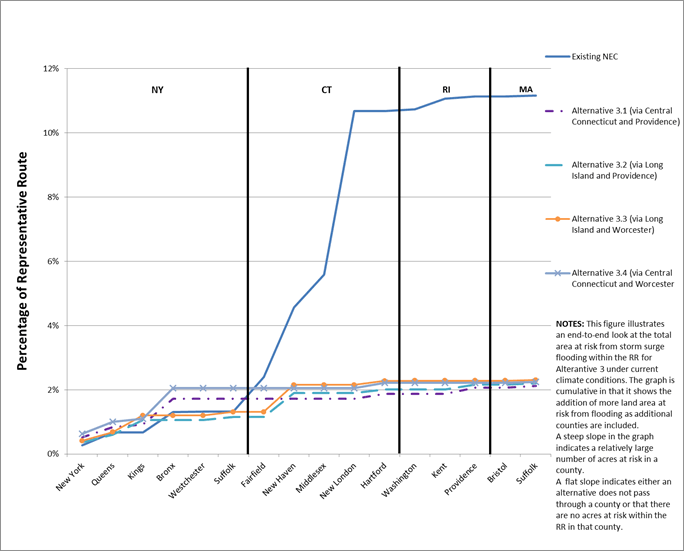
Source: NEC FUTURE team, 2015
Figure 7.15-14 : Current Climate Conditions (Storm Surge Flooding): Construction Type - Total Percentage of Representative Route of Alternative 3 (New York County, NY, and Suffolk County, MA, Route Option) and the Existing NEC at Risk
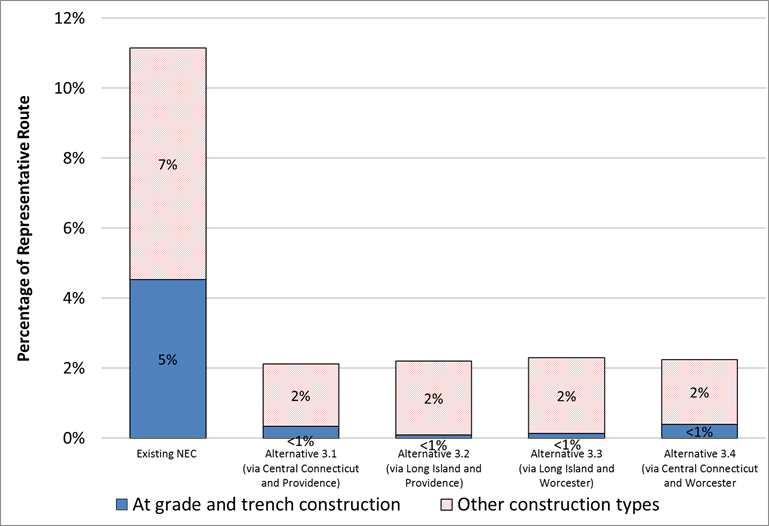
Source: NEC FUTURE team, 2015.
Figure 7.15-15 : Current Climate Conditions (Riverine Flooding): Total Percentage of Representative Route of Alternative 3 (New York County, NY, and Suffolk County, MA, Route Option) and the Existing NEC at Risk
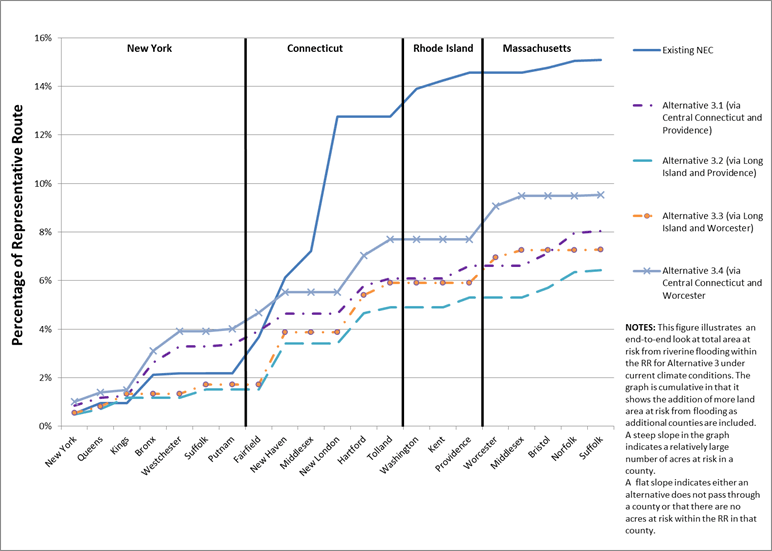
Source: NEC FUTURE team, 2015
Figure 7.15-16 : Current Climate Conditions (Riverine Flooding): Construction Type - Total Percentage of Representative Route of Alternative 3 (New York County, NY, and Suffolk County, MA, Route Option) and the Existing NEC at Risk
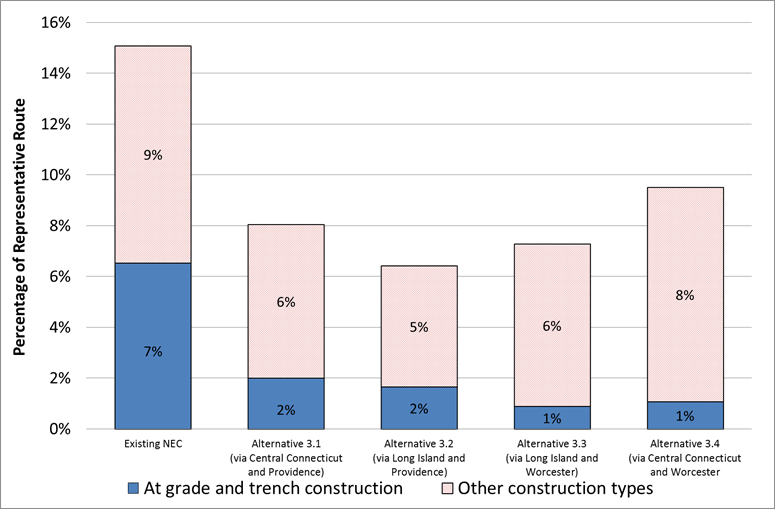
Source: NEC FUTURE team, 2015
Considering the constructions types that are most vulnerable to inundation from flooding, Figure 7.15-14 (storm surge flooding) and Figure 7.15-16 (riverine flooding) further emphasize the resilience benefits of the Alternative 3 route options. For Alternative 3, less than 1.5 percent of the acreage at risk from storm surge flooding in the Representative Route related to at-grade or trench construction type, compared to approximately 5 percent of the existing NEC.
Between 1 percent and 2 percent of the acreage at risk from riverine flooding in the Representative Route of the Alternative 3 route options are related to at-grade or trench construction type, compared to approximately 7 percent of the existing NEC.
Figure 7.15-4 summarizes, by Action Alternative, the total number of stations at risk of inundation under each timeframe. Appendix E, Section E.15 contains a detailed county-level listing of the stations at risk of inundation along each Action Alternative.
| Alternative 1 | Alternative 2 | Alternative 3 | |
|---|---|---|---|
| CURRENT CLIMATE CONDITIONS | |||
| Total New Stations At Risk of Inundation | 7 | 10 | 15-16 |
| Total Existing Stations At Risk of Inundation* | 54 | 55 | 55 |
| Total Number of Stations At Risk of Inundation | 61 | 65 | 70-71 |
| MID-CENTURY CLIMATE CONDITIONS | |||
| Total New Stations At Risk of Inundation | 10 | 12 | 32-33 |
| Total Existing Stations At Risk of Inundation* | 61 | 61 | 47 |
| Total Number of Stations At Risk of Inundation | 71 | 73 | 79-80 |
| END-OF-CENTURY CLIMATE CONDITIONS | |||
| Total New Stations At Risk of Inundation | 10 | 12 | 15-17 |
| Total Existing Stations At Risk of Inundation* | 63 | 63 | 65 |
| Total Number of Stations At Risk of Inundation | 73 | 75 | 80-82 |
Source: NEC FUTURE team, 2015
Note: The numbers in this table represent the total number of stations at risk from one or more flood hazard.
* The analysis assumes that existing stations are those that are included in the No Action Alternative.
There would be a small difference in the number of stations at risk of inundation across the Action Alternatives. Each Action Alternative has a similar profile of the risk from each flooding hazard with riverine flooding accounting for a significant portion of the total number of stations at risk of inundation. For example under Alternative 1, there would be 37 stations at risk from sea level rise flooding and coastal storm surge flooding. An additional 24 stations would be at risk of inundation when considering riverine flooding for Alternative 1. While the total number of stations at risk increases under mid-century and end-of-century climate conditions, the risk profile from each flooding hazard is similar to that of the current climate conditions with riverine flooding accounting for a significant portion of the total number of stations at risk.
Considerable portions of the Affected Environment associated with the existing NEC and Action Alternatives are already close to the coast and are at risk from sea level rise flooding and coastal storm surge flooding. Within the Context Area, any shift in the route closer to the coast would likely increase the risk of inundation from these flooding mechanisms. Conversely, shifting away from the coastline could reduce the area at risk.
Considerable portions of the Affected Environment associated with the existing NEC and Action Alternatives are already at risk from riverine flooding under current climate conditions. As the climate changes, the size of these flood hazard areas within the Context Area would likely increase.
A review of the flood hazard areas under current climate conditions identified that changes to the route within the Context Area could lead to greater increases in flood risk in the following counties:
The counties listed above are consistent with those identified under the impacts to the Affected Environment.
These findings are applicable to all three time periods (i.e., current climate, mid-century, and end-of-century). The number of acres at risk within the Context Area would increase as the hazard extents increase under each future scenario (e.g., with sea level rise and increases in the frequency and intensity of extreme rainfall events at mid-century and end-of-century).
The effects of climate change also extend to extreme changes in temperatures. Temperatures that are abnormally high or low can also result in effects to rail infrastructure. When rails are exposed to prolonged periods of heat or cold temperatures it can cause rail to crack, buckle, pull apart or separate resulting in service disruption and delays. As presented in Table 7.15-2, the extreme temperature-related impacts to rail assets and operations include the following:
Figure 7.15-17 : Example of Rail Buckle from Extreme Heat
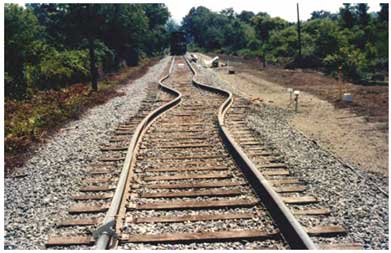
Source: U.S. DOT Volpe Center in Federal Transit Administration. (2011). Flooded Bus Barns and Buckled Rails: Public Transportation and Climate Change Adaptation. Retrieved 2015, from http: //www.fta.dot.gov/documents/FTA_0001_-_Flooded_Bus_Barns_and_Buckled_Rails.pdf.
Factors that influence the occurrence of pull-aparts or buckling include the temperature of the track at the time it is installed (i.e., the rail neutral temperature), the age of the track, maintenance of the track (e.g., if there has been adjustments in a prior season to accommodate heat or cold), the use of the track, solar radiation, wind, and the ambient air temperature.
Buckling is a catastrophic event that significantly increases the likelihood of derailment. However, pull-aparts are seen as a lower consequence risk event since they typically are detected through the signaling system or by train engineers, and small breaks can be driven over without causing a derailment.
Information provided by the FRA's Office of Research and Development indicates that there tend to be more buckles in the early summer, often as a result of unreported fixes of winter breaks where more track is added, which lowers the neutral temperature of the track. Slow orders (i.e., requests to operate the trains at a slower speed) are a key response to managing the impacts of extreme heat events. Slow orders minimize the likelihood of track buckling or derailment during an extreme heat event. A slow order may be for the whole day, or may be increased as the day continues.4
Each railroad has its own policy regarding slow orders and the relevant thresholds that trigger them:
Recognizing there is a range of temperatures of interest, the FRA evaluated three temperature projections for the average number of days where the maximum temperatures exceed 80°F, 95°F, and 110°F (Figure 7.15-18) under historical average (1959-1999), mid-century, and end-of-century scenarios. State-based projections provide an average of the climate data available for grid references closest to the Action Alternative routes, rather than an average for the entire state.
All states and Washington, D.C., on average, historically experienced more than 50 days a year where the maximum temperature exceeds 80°F, with Washington, D.C., and Maryland recording more than 100 days per year. The number of days per year above 80°F is projected to increase by 36-46 days at mid-century and 58-74 days at end-of-century. While the increase in the total number of days per year above 80°F is similar across all states, the projected percentage of days per year above 80°F increases for mid-century and end-of-century are highest for New York (63 percent and 103 percent, respectively), Connecticut (77 percent and 124 percent, respectively), Rhode Island (92 percent and 148 percent, respectively), and Massachusetts (80 percent and 129 percent, respectively).
The projected increase in the number of days per year above 95°F is most dramatic for the southern-most states (Maryland, Washington, D.C., Delaware, Pennsylvania, and New Jersey). These states historically experienced 3-6 days annually above 95°F and are projected to experience a total of 17-34 days at mid-century, and 47-72 days at the end-of century. Figure 7.15-18 illustrates the projected change in days over 95°F in each state by the mid-century.
Historically (1950-1999), on average, the temperature threshold of 110°F has not been exceeded along the Action Alternative routes. For all states, this is not projected to change at mid-century, with minimal (i.e., <0.5 day) projected at the end-of-century.
In North America, climate change is projected to result in increases in hot days and extended warm spells (i.e., heat waves), reductions in cold days, cold nights and frosts, and more rapid increases in minimum temperature extremes than maximum temperature extremes.6 However, the frequency and duration of extreme cold events in the Northeast may be affected by potential increases in "blocking" events, described by the National Climate Assessment (NCA) as large-scale weather patterns with little or no movement.7 The NCA acknowledges that further research is required since conclusions about trends in "blocking" depend on the method of analysis. Because of the uncertainty of the climate change-related influence on this hazard, the FRA has made no quantitative projections. Table 7.15-2 provides a qualitative listing of the potential effects of extreme cold events (including effects of snow and ice) on rail assets.
Under all Action Alternatives, there would be a net total decrease in GHG emissions in the year 2040, when compared to the No Action Alternative.
Flood and extreme temperature-related impacts affect the existing NEC (including the No Action Alternative) and will also affect all Action Alternatives. The risks and associated impacts are likely to increase under mid-century and end-of-century climate conditions. While a significant portion of the existing NEC is along the coast, the Action Alternatives provide a mix of inland and coastal routes, particularly in the northern half of the Study Area. Analyses showed that rail assets and infrastructure associated with inland routes are at much lower risk of coastal flooding than coastal routes. Rail assets located in counties along inland routes, however, are still subject to riverine flooding, as is the existing NEC. The geographic area of those risks is likely to increase as a result of climate change.
Figure 7.15-18 : Average Annual Number of Days Equal to or Above 95°F, by Climate Scenario
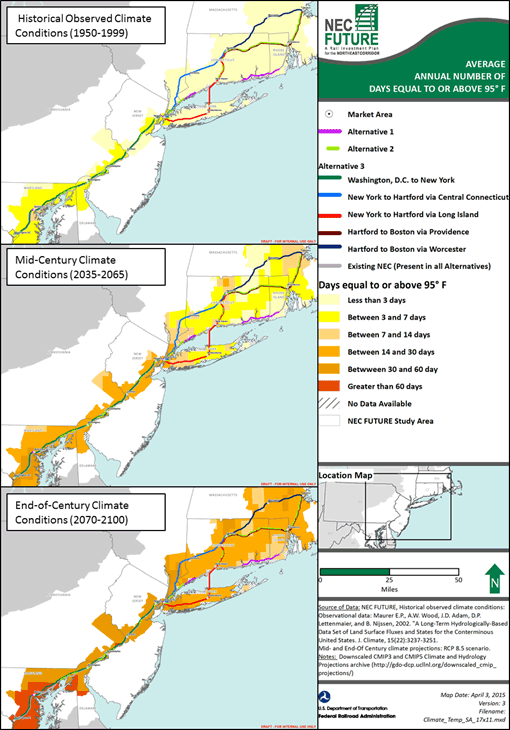
Sources: NEC FUTURE team, Historical observed climate conditions: Observational data: Maurer E.P., A.W. Wood, J.D. Adam, D.P. Lettenmaier, and B. Nijssen, 2002. "A Long-Term Hydrologically-Based Data Set of Land Surface Fluxes and States for the Conterminous United States. J. Climate, 15(22):3237-3251. Mid- and End-Of Century climate projections: RCP 8.5 scenario.
Notes: Downscaled CMIP3 and CMIP5 Climate and Hydrology Projections archive (http: //gdo-dcp.ucllnl.org/downscaled_cmip_projections/)
The No Action Alternative and Action Alternatives all require investment to improve the resiliency of the existing NEC infrastructure. The resiliency and redundancy provided by the Action Alternatives north of New York City provide a benefit as compared to the No Action Alternative. Investment in new infrastructure associated with the off-corridor sections of the Action Alternatives, particularly Alternative 3, provides an opportunity to locate and design the infrastructure in a way that minimizes its risk to flood and extreme heat related impacts. The following section presents potential mitigation and adaptation strategies.
Understanding that the effects of climate change will continue to worsen, it is important to consider ways in which to make improvements to the existing and new rail infrastructure that can better withstand the potential effects on inundation and extreme weather events. This section provides an overview of potential mitigation and adaptation strategies that could be considered during future stages of project development. Chapter 7.13, Air Quality, provides potential mitigation to reduce GHG emissions.
The earlier that adaptation approaches are considered in the infrastructure planning and design process, the lower the relative cost and potential disruption associated with implementing the changes. For example, the marginal cost of building an embankment to a higher elevation when it is first built is significantly cheaper, and less disruptive, than increasing the height of an existing embankment and the assets it supports.
Multiple approaches can be used to adapt rail service and infrastructure to future climate and therefore minimize the risk of flood or extreme temperature-related impacts. Typical categories of response include the following:
The FRA reviewed climate change-related policies and initiatives that have been published by various government agencies in Washington, D.C., and the eight states along the NEC. From these sources, the FRA identified the following common themes:
The NEC FUTURE has taken action related to each of these themes by integrating consideration of climate change into the Tier 1 EIS process. The climate change analysis has engaged with planning agencies, considered climate change projections, and assessed the vulnerability of rail assets.
Table 7.15-5 provides a listing of potential adaptation actions relevant to each asset class and the risks they face from flood and extreme temperatures. In addition to asset-specific adaptation actions, Action Alternatives that include an inland option provide benefits, improving the adaptive capacity of the system (e.g., Alternatives 2 and 3). The existence of an inland route may assist in reducing service disruptions should a coastal flooding event affect assets along the coast.
In developing adaptation options specific to the NEC, consideration should be given to regional or state-based adaptation actions that may reduce the risk profile of the existing NEC and the Action Alternatives.
Appendix E, Section E.15, provides the limitations of this assessment. Key actions that may be undertaken as part of Tier 2 project analysis and design should include the following:
The above analysis may be guided by the Federal Highway Administration's Virtual Framework for Vulnerability Assessment. Table 7.15-6 provides an overview of the modules contained in the framework and how they may be applied to Tier 2 analysis. In addition, consideration should be given to the Revised Guidelines for Implementing Executive Order 11988, Floodplain Management. 8
| Asset | Risk | Adaptation Actions |
|---|---|---|
| BUILT ASSETS | ||
| Rail tracks (at-grade, embankment, trench, and tunnel construction) |
|
|
| Station platforms |
|
|
| Station buildings |
|
|
| Storage facilities for rail vehicles |
|
|
| Storage facilities for maintenance equipment |
|
|
| Electrical equipment (substations, overhead power / catenary wires, signaling, communications, security lighting, supporting retail / activity centers and emergency equipment (e.g., backup generators, firefighting / water pumps for flood treatment) |
|
|
| Bridge structures (aerial and major bridge construction) |
|
|
| Retaining walls (embankment and tunnel construction) |
|
|
| Vehicles |
|
|
| Noise walls |
|
|
| HUMAN ASSETS (access to / from, health and safety during use / operation) |
||
| Operational staff |
|
|
| Passengers / commuters |
|
|
| SUPPORTING SERVICES | ||
| Electricity supply |
|
|
| Emergency response |
|
|
Source: NEC FUTURE team, 2015
| Framework Module | Relevance to Tier 2 Analysis |
|---|---|
| Module 1: Articulate Objectives Includes:
|
Guidance related to this module could assist in setting the scope of Tier 2 analysis. The NEC FUTURE Tier 1 analysis can inform the articulation of objectives. |
| Module 2: Identify Key Climate Stressors Includes selecting climate stressors to analyze, based on the sensitivity of transportation assets |
The Tier 1 assessment has selected climate stressors relating to flooding and extreme temperature as the focus. Tier 2 analyses may consider a broader set of climate stressors (refer to U.S. DOT's Sensitivity Matrix developed as a part of the U.S. DOT Gulf Coast study). |
| Module 3: Select and Characterize Relevant Assets Includes determining the following:
|
Guidance related to this module could be of use in developing the scope for Tier 2 analysis (refer to Guide to Assessing Criticality in Transportation Adaptation Planning developed as a part of the U.S. DOT Gulf Coast Study). |
| Module 4: Assess Vulnerabilities Includes assessing sensitivity, exposure and adaptive capacity of assets and the associated risks |
Guidance related to this module could be of use in developing the scope for Tier 2 analysis (refer to the U.S. DOT Vulnerability Assessment Scoring Tool). |
| Module 5: Integrate Vulnerabilities into Decision Making Includes identifying, analyzing, and prioritizing adaptation options |
The work undertaken in the Tier 1 EIS is a demonstration of how vulnerabilities are being considered in the decision-making process. Guidance related to adaptation planning may be of benefit in Tier 2 analysis. |
| Module 6: Monitor and Revisit Includes developing and implementing a monitoring and evaluation plan, engaging stakeholders, evaluating outcomes, revisiting inputs into the assessment (e.g., climate data, information on assets or operations) |
These elements should be considered in the development of adaptation options and ongoing planning for the NEC FUTURE. |
Sources:
1. NEC FUTURE team, 2015
2. U.S. Department of Transportation - Federal Highway Administration. (2015, February 2). Gulf Coast Study, Phase 2 Task 4. Retrieved February 23, 2015, from Federal Highway Administration: http://www.fhwa.dot.gov/environment/climate_change/adaptation/ongoing_and_current_research/
gulf_coast_study/phase2_task4/index.cfm 3. U.S. Department of Transportation - Federal Highway Administration. (2015, February 2). Virtual Framework for Vulnerability Assessment. Retrieved February 23, 2015, from Federal Highway Administration: http://www.fhwa.dot.gov/environment/climate_change/adaptation/adaptation_framework/
1 U.S. Environmental Protection Agency. (2014, March 18). Climate Change: Basic Information. Retrieved September 10, 2014, from United States Environment Protection Agency: http: //www.epa.gov/climatechange/basics/
2 Federal Insurance and Mitigation Administration (FIMA) & Federal Emergency Management Agency (FEMA). (2013). The Impact of Climate Change and Population Growth on the National Flood Insurance Program through 2100. http: //www.nfrmp.us/frmpw/2013webinarweek/docs/E3%20Coastal%20Climate%20Change/
E3_FEMA_MarkCrowell_climate_change3.pdf
3 Climate Change Impacts in the United States. Retrieved August 15, 2014, from http://www.globalchange.gov/browse/reports/global-climate-change-impacts-united-states; and Transportation Research Board. (2008). Special Report 290: Potential Impacts of Climate Change on U.S. Transportation. National Research Council. Committee on Climate Change and U.S. Transportation. Washington, D.C.: Transportation Research Board. Retrieved 2014 from http: //onlinepubs.trb.org/onlinepubs/sr/sr290.pdf
4 Al-Nazer, L. F. (2014a, August 15). Heat Event Thresholds for Rail Performance - NEC Future EIS : Phone discussion. (N. F. Team, Interviewer)
5 Email from Leith Al-Nezar (2014b, August 15). Washington, D.C., USA. U.S. DOT
6 Intergovernmental Panel on Climate Change (IPCC). (2013). Summary for Policymakers. In: Climate Change 2013: The Physical Science Basis. Contribution of Working Group I to the Fifth Assessment Report of the Intergovernmental Panel on Climate Change. New York: Cambridge University Press.
7 U.S. Global Change Research Program. (2014). 2014 National Climate Assessment. Retrieved from http: //nca2014.globalchange.gov/
8 Federal Emergency Management. (Revised 2015). Agency Guidelines for Implementing Executive Order 11988, Floodplain Management. Retrieved from http: //www.fema.gov/media-library-data/1422653213069-9af488f43e1cf4a0a76ae870b2dcede9/DRAFT-FFRMS-
Implementating-Guidelines-1-29-2015r2.pdf
The information posted on this website includes hypertext links or pointers to information created and maintained by other public and/or private organizations. The FRA provides these links and pointers solely for information and convenience. When users select a link to an outside website, they are leaving the NEC FUTURE website and are subject to the privacy and security policies of the owners/sponsors of the outside website. The FRA does not control or guarantee the accuracy, relevance, timeliness or completeness of information contained on a linked website, or endorse the organizations sponsoring linked websites, the views they express, or the products/services they offer. The FRA cannot authorize the use of copyrighted materials contained in linked websites and is not responsible for transmissions users receive from linked websites.